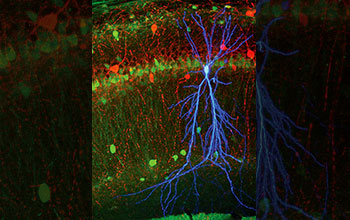Multimedia Gallery
A stained pyramidal cell in mouse hippocampus
A stained pyramidal cell (in blue) in area CA1 -- a part of the hippocampus that is thought to be an important relay station for memories -- of a mouse hippocampus. Neurons expressing calbindin are shown in green and inhibitory neurons expressing parvalbumin are shown in red. During intracellular recording of the neuron’s membrane potential, the pyramidal cell was filled with dye so it could be located and imaged.
More about this image
Neuroscientists at the California Institute of Technology have looked inside brain cells as they undergo the intense bursts of neural activity known as "ripples" that are thought to underlie memory formation.
During ripples, a small fraction of brain cells, or neurons, fire synchronously in area CA1, a part of the hippocampus that is thought to be an important relay station for memories. "During a ripple, about 10% of the neurons in CA1 are activated, and these active neurons all fire within a tenth of a second," says Caltech graduate student Brad Hulse. "Two big questions have been -- how do the remaining 90% of CA1 neurons stay quiet? And what is synchronizing the firing of the active neurons?"
Hulse and his colleagues used a novel approach to show how the combination of excitatory and inhibitory inputs to CA1 work together to synchronize the firing of active neurons, while keeping most neurons silent during ripples.
The researchers used two techniques in tandem to monitor the activity inside a single neuron while still observing how the larger network was behaving. This in turn enabled them to piece together how excitatory inputs from CA3, a hippocampal region where memories are formed, affect the output of brain cells called pyramidal neurons in CA1. These neurons are important for transferring newly coded memories to other brain areas such as the neocortex for safekeeping and long-term storage. Ripples are thought to be the mechanism by which this transfer occurs.
This research was supported by the U.S. National Science Foundation (grant IOS 1146871).
Read more about this research in the Caltech news story Studying memory's 'ripples'. (Date image taken: 2015-2016; date originally posted to NSF Multimedia Gallery: Sept. 13, 2018)
Credit: Image courtesy of T. Siapas/Caltech
Images and other media in the National Science Foundation Multimedia Gallery are available for use in print and electronic material by NSF employees, members of the media, university staff, teachers and the general public. All media in the gallery are intended for personal, educational and nonprofit/non-commercial use only.
Images credited to the National Science Foundation, a federal agency, are in the public domain. The images were created by employees of the United States Government as part of their official duties or prepared by contractors as "works for hire" for NSF. You may freely use NSF-credited images and, at your discretion, credit NSF with a "Courtesy: National Science Foundation" notation.
Additional information about general usage can be found in Conditions.
Also Available:
Download the high-resolution JPG version of the image. (1.3 MB)
Use your mouse to right-click (Mac users may need to Ctrl-click) the link above and choose the option that will save the file or target to your computer.



